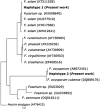First data on microflora of loggerhead sea turtle (Caretta caretta) nests from the coastlines of Sicily
- PMID: 31915211
- PMCID: PMC6994955
- DOI: 10.1242/bio.045252
First data on microflora of loggerhead sea turtle (Caretta caretta) nests from the coastlines of Sicily
Abstract
Caretta caretta is threatened by many dangers in the Mediterranean basin, but most are human-related. The purposes of this research were: (i) to investigate microflora in samples from six loggerhead sea turtle nests located on the Sicilian coast and (ii) to understand microbial diversity associated with nests, with particular attention to bacteria and fungi involved in failed hatchings. During the 2016 and 2018 summers, 456 eggs and seven dead hatchling from six nests were collected. We performed bacteriological and mycological analyses on 88 egg samples and seven dead hatchlings, allowing us to isolate: Fusarium spp. (80.6%), Aeromonas hydrophila (55.6%), Aspergillus spp. (27.2%) and Citrobacter freundii (9%). Two Fusarium species were identified by microscopy and were confirmed by PCR and internal transcribed spacer sequencing. Statistical analyses showed significant differences between nests and the presence/absence of microflora, whereas no significant differences were observed between eggs and nests. This is the first report that catalogues microflora from C . caretta nests/eggs in the Mediterranean Sea and provides key information on potential pathogens that may affect hatching success. Moreover, our results suggest the need for wider investigations over extensive areas to identify other microflora, and to better understand hatching failures and mortality related to microbial contamination in this important turtle species.
Keywords: Caretta caretta; Fusarium; Mediterranean Sea; Microflora; Sea turtle eggs.
© 2020. Published by The Company of Biologists Ltd.
Conflict of interest statement
Competing interestsThe authors declare no competing or financial interests.
Figures


Similar articles
-
Unveiling the egg microbiota of the loggerhead sea turtle Caretta caretta in nesting beaches of the Mediterranean Sea.PLoS One. 2022 May 26;17(5):e0268345. doi: 10.1371/journal.pone.0268345. eCollection 2022. PLoS One. 2022. PMID: 35617269 Free PMC article.
-
Asynchronous emergence by loggerhead turtle (Caretta caretta) hatchlings.Naturwissenschaften. 2001 Mar;88(3):133-6. doi: 10.1007/s001140100212. Naturwissenschaften. 2001. PMID: 11402844
-
Fusarium species isolated from post-hatchling loggerhead sea turtles (Caretta caretta) in South Africa.Sci Rep. 2022 Apr 7;12(1):5874. doi: 10.1038/s41598-022-06840-1. Sci Rep. 2022. PMID: 35393437 Free PMC article.
-
Potential impacts of environmental bacteria on the microbiota of loggerhead (Caretta caretta) and green (Chelonia mydas) sea turtle eggs and their hatching success.Microbiologyopen. 2023 Jun;12(3):e1363. doi: 10.1002/mbo3.1363. Microbiologyopen. 2023. PMID: 37379420 Free PMC article.
-
Modeling the impacts of natural and human factors on the hatching success of the loggerhead sea turtle Caretta caretta along the coasts of Italy.PLoS One. 2025 Apr 9;20(4):e0320733. doi: 10.1371/journal.pone.0320733. eCollection 2025. PLoS One. 2025. PMID: 40202956 Free PMC article.
Cited by
-
Is Caretta Caretta a Carrier of Antibiotic Resistance in the Mediterranean Sea?Antibiotics (Basel). 2020 Mar 10;9(3):116. doi: 10.3390/antibiotics9030116. Antibiotics (Basel). 2020. PMID: 32164241 Free PMC article.
-
Loggerhead Sea Turtles as Hosts of Diverse Bacterial and Fungal Communities.Microb Ecol. 2024 May 30;87(1):79. doi: 10.1007/s00248-024-02388-x. Microb Ecol. 2024. PMID: 38814337 Free PMC article.
-
Antibiotic Susceptibility Profile and Tetracycline Resistance Genes Detection in Salmonella spp. Strains Isolated from Animals and Food.Antibiotics (Basel). 2021 Jul 2;10(7):809. doi: 10.3390/antibiotics10070809. Antibiotics (Basel). 2021. PMID: 34356729 Free PMC article.
-
Unveiling the egg microbiota of the loggerhead sea turtle Caretta caretta in nesting beaches of the Mediterranean Sea.PLoS One. 2022 May 26;17(5):e0268345. doi: 10.1371/journal.pone.0268345. eCollection 2022. PLoS One. 2022. PMID: 35617269 Free PMC article.
-
Antibiotic Resistance of Gram-Negative Bacteria from Wild Captured Loggerhead Sea Turtles.Antibiotics (Basel). 2020 Apr 6;9(4):162. doi: 10.3390/antibiotics9040162. Antibiotics (Basel). 2020. PMID: 32268481 Free PMC article.
References
-
- Al-Bahry S., Mahmoud I., Elshafie A., Al-Harthy A., Al-Ghafri S., Al-Amri I. and Alkindi A. (2009). Bacterial flora and antibiotic resistance from eggs of green turtles Chelonia mydas: an indication of polluted effluents. Mar. Pollut. Bull. 58, 720-725. 10.1016/j.marpolbul.2008.12.018 - DOI - PubMed
-
- Anderson M. J., Gorley R. N. and Robert Clarke K. (2008). PERMANOVA+ for primer: Guide to software and statistical methods. PRIMER-E. UK: Plymouth.
-
- Awong-Taylor J., Craven K. S., Griffiths L., Bass C. and Muscarella M. (2008). Comparison of biochemical and molecular methods for the identification of bacterial isolates associated with failed loggerhead sea turtle eggs. J. Appl. Microbiol. 104, 1244-1251. 10.1111/j.1365-2672.2007.03650.x - DOI - PubMed
-
- Bailey J. B., Lamb M., Walker M., Weed C. and Craven K. S. (2018). Detection of potential fungal pathogens Fusarium falciforme and F. keratoplasticum in unhatched loggerhead turtle eggs using a molecular approach. Endanger. Species Res. 36, 111-119. 10.3354/esr00895 - DOI
MeSH terms
LinkOut - more resources
Full Text Sources
Miscellaneous

